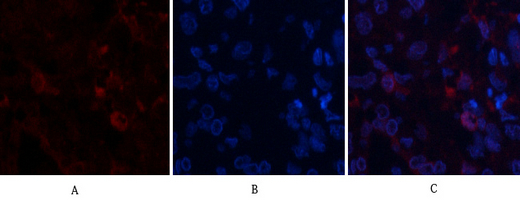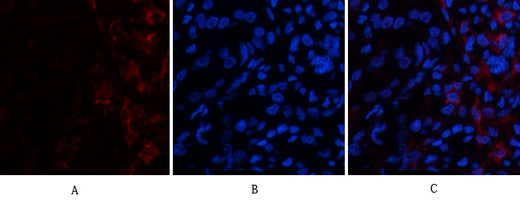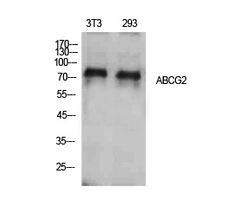ABCG2 Polyclonal Antibody
- 货号:YT5558
- 应用:IF;WB;IHC;ELISA
- 种属:Human;Rat;Mouse;
- 简介:
- >>Antifolate resistance;>>ABC transporters;>>Bile secretion
- 蛋白名称:
- ATP-binding cassette sub-family G member 2
- 免疫原:
- The antiserum was produced against synthesized peptide derived from the Internal region of human ABCG2. AA range:461-510
- 特异性:
- ABCG2 Polyclonal Antibody detects endogenous levels of ABCG2 protein.
- 组成:
- Liquid in PBS containing 50% glycerol, 0.5% BSA and 0.02% sodium azide.
- 来源:
- Polyclonal, Rabbit,IgG
- 稀释:
- IF 1:50-200 WB 1:500 - 1:2000. IHC: 1:100-1:300. ELISA: 1:10000. Not yet tested in other applications.
- 纯化工艺:
- The antibody was affinity-purified from rabbit antiserum by affinity-chromatography using epitope-specific immunogen.
- 储存:
- -15°C to -25°C/1 year(Do not lower than -25°C)
- 其他名称:
- ABCG2;ABCP;BCRP;BCRP1;MXR;ATP-binding cassette sub-family G member 2;Breast cancer resistance protein;CDw338;Mitoxantrone resistance-associated protein;Placenta-specific ATP-binding cassette transporter;CD338
- 背景:
- The membrane-associated protein encoded by this gene is included in the superfamily of ATP-binding cassette (ABC) transporters. ABC proteins transport various molecules across extra- and intra-cellular membranes. ABC genes are divided into seven distinct subfamilies (ABC1, MDR/TAP, MRP, ALD, OABP, GCN20, White). This protein is a member of the White subfamily. Alternatively referred to as a breast cancer resistance protein, this protein functions as a xenobiotic transporter which may play a major role in multi-drug resistance. It likely serves as a cellular defense mechanism in response to mitoxantrone and anthracycline exposure. Significant expression of this protein has been observed in the placenta, which may suggest a potential role for this molecule in placenta tissue. Multiple transcript variants encoding different isoforms have been found for this gene.
- 功能:
- function:Xenobiotic transporter that may play an important role in the exclusion of xenobiotics from the brain. May be involved in brain-to-blood efflux. Appears to play a major role in the multidrug resistance phenotype of several cancer cell lines. When overexpressed, the transfected cells become resistant to mitoxantrone, daunorubicin and doxorubicin, display diminished intracellular accumulation of daunorubicin, and manifest an ATP-dependent increase in the efflux of rhodamine 123.,induction:Up-regulated in brain tumors.,PTM:Glycosylation-deficient ABCG2 is normally expressed and functional.,similarity:Belongs to the ABC transporter family. ABCG (White) subfamily.,similarity:Contains 1 ABC transmembrane type-2 domain.,similarity:Contains 1 ABC transporter domain.,subunit:Monomer or homodimer; disulfide-linked.,tissue specificity:Highly expressed in placenta. Low expression in small i
- 细胞定位:
- Cell membrane ; Multi-pass membrane protein . Apical cell membrane ; Multi-pass membrane protein . Mitochondrion membrane ; Multi-pass membrane protein . Enriched in membrane lipid rafts. .
- 组织表达:
- Highly expressed in placenta (PubMed:9850061). Low expression in small intestine, liver and colon (PubMed:9861027). Expressed in brain (at protein level) (PubMed:12958161).

- Immunofluorescence analysis of human-breast-cancer tissue. 1,ABCG2 Polyclonal Antibody(red) was diluted at 1:200(4°C,overnight). 2, Cy3 labled Secondary antibody was diluted at 1:300(room temperature, 50min).3, Picture B: DAPI(blue) 10min. Picture A:Target. Picture B: DAPI. Picture C: merge of A+B

- Immunofluorescence analysis of human-lung-cancer tissue. 1,ABCG2 Polyclonal Antibody(red) was diluted at 1:200(4°C,overnight). 2, Cy3 labled Secondary antibody was diluted at 1:300(room temperature, 50min).3, Picture B: DAPI(blue) 10min. Picture A:Target. Picture B: DAPI. Picture C: merge of A+B

- Immunofluorescence analysis of human-lung-cancer tissue. 1,ABCG2 Polyclonal Antibody(red) was diluted at 1:200(4°C,overnight). 2, Cy3 labled Secondary antibody was diluted at 1:300(room temperature, 50min).3, Picture B: DAPI(blue) 10min. Picture A:Target. Picture B: DAPI. Picture C: merge of A+B

- Immunofluorescence analysis of human-kidney tissue. 1,ABCG2 Polyclonal Antibody(red) was diluted at 1:200(4°C,overnight). 2, Cy3 labled Secondary antibody was diluted at 1:300(room temperature, 50min).3, Picture B: DAPI(blue) 10min. Picture A:Target. Picture B: DAPI. Picture C: merge of A+B

- Immunofluorescence analysis of human-kidney tissue. 1,ABCG2 Polyclonal Antibody(red) was diluted at 1:200(4°C,overnight). 2, Cy3 labled Secondary antibody was diluted at 1:300(room temperature, 50min).3, Picture B: DAPI(blue) 10min. Picture A:Target. Picture B: DAPI. Picture C: merge of A+B

- Western Blot analysis of NIH-3T3, 293 cells using ABCG2 Polyclonal Antibody. Antibody was diluted at 1:500. Secondary antibody(catalog#:RS0002) was diluted at 1:20000









